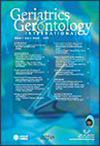Association between the presence or absence of muscle mass assessment in sarcopenia diagnosis and poor health outcomes: A follow-up study of older outpatients at a frailty clinic
Abstract
Aim
Recently, some researchers have questioned the inclusion of muscle mass as a diagnostic criterion for sarcopenia. We examined the longitudinal association between the presence or absence of muscle mass assessment in sarcopenia diagnosis and the incidence of poor health outcomes.
Methods
This 1-year follow-up study included 730 Japanese outpatients aged ≥65 years without disabilities who visited the frailty clinic. The participants were classified into four groups: robust; low muscle mass only; low grip strength and/or physical function only; and low muscle mass with low grip strength and/or low physical function (sarcopenia) based on the Asian Working Group for Sarcopenia 2019 definition. Muscle mass was assessed using dual-energy X-ray absorptiometry and a bioelectrical impedance analysis. The outcome measure was poor health status, defined as experiencing one or more falls, nursing home admissions or hospitalizations.
Results
The multiple logistic regression analysis, adjusted for sex, age, body mass index, cognitive impairment, depressive symptoms, polypharmacy, multimorbidity, pre-orthopedic surgery, undergoing cancer treatment and stroke history, determined the odds ratios (95% confidence intervals) for outcomes with robust used as the reference group were: low muscle mass only 0.84 (0.52–1.35); low grip strength or physical function only 1.04 (0.71–1.53); and sarcopenia 2.00 (1.39–2.87).
Conclusion
Only participants who had muscle weakness and/or reduced physical function in addition to muscle mass loss were associated with poor health outcome incidence. Excluding muscle mass assessment from the sarcopenia diagnosis might lead to missing a population that requires attention. Geriatr Gerontol Int 2025; 25: 553–559.


 求助内容:
求助内容: 应助结果提醒方式:
应助结果提醒方式:


